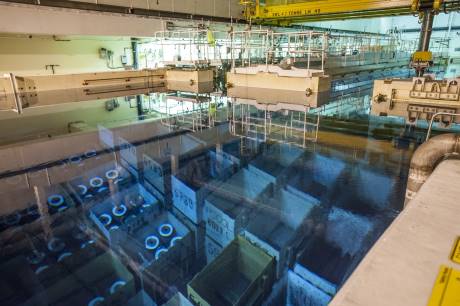Decommissioning milestones at Magnox sites
12 August 2015
Magnox Limited has announced the completion of fuel removal from unit 1 of the Oldbury nuclear power plant in the UK as well as the retrieval of all fuel element debris from underground vaults at the Bradwell site.
 |
| Oldbury's on-site fuel storage ponds (Image: NDA) |
Defuelling began at Oldbury in early 2013, and is a key part of the decommissioning process. Fuel is removed from the reactors and then stored in on-site ponds before being transported in flasks to the Sellafield site for reprocessing. There were a total of 52,060 used nuclear fuel elements at the two-unit plant when it ceased operating.
Magnox Limited yesterday announced that it has now completed the removal of all 25,826 fuel elements - each measuring 1.1 meters in length - from the reactor of unit 1 at Oldbury in Gloucestershire. The unit ceased operation in February 2012, after more than 44 years of commercial operation, with unit 2 closing in June 2011. The two 217 MWe units are owned by the UK's Nuclear Decommissioning Authority.
Oldbury 2 is currently 85% defuelled, with completion scheduled in October, Magnox Limited said. By that time, some 26,235 fuel elements would have been removed from that reactor.
Oldbury site director Mike Heaton commented, "This is yet another milestone in the life of the site and we will continue to press ahead to complete defuelling the reactors by the end of the year." He added, "Our aim is to ship all the remaining fuel to Sellafield by the early part of next year."
When all the fuel has been shipped, the site will have removed 99% of its radioactive hazard, the company noted.
Fuel debris removal
Magnox Limited also announced the retrieval of all bulk fuel element debris (FED) from underground storage vaults at the Bradwell site in Essex.
Before used Magnox fuel from Bradwell was shipped to Sellafield for reprocessing, some of the metal casing was removed to allow for greater packaging efficiency. This debris - the FED - is not the fuel itself and is primarily magnesium, with small amounts of other metals.
In what it describes as a "significant step towards dealing with legacy waste" at the Bradwell site, the company said that more than 200 tonnes of FED have been removed from the vaults over the past three years. The waste has been packaged into drums ready for processing, it said. Decontaminate work at the vaults is under way, with eight of the 12 vaults already completed. Some 10% of the FED has already been treated using a dissolution plant at the Dungeness A plant in Kent.
Bradwell site director Scott Raish said, "Our goal is to reduce the risk and associated hazard at the site. Completing retrieval of FED significantly lowers the risk as we now have clarity about the volume of waste that needs to be processed, it is safely packaged in modern, fit-for-purpose drums and is regularly monitored and inspected ahead of processing."
The Bradwell plant shut down in 2002, with defuelling completed in 2006.
Researched and written
by World Nuclear News